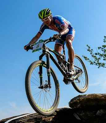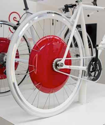By Karen Kefauver – Sentinel correspondent
August 7, 2009
Link to Sentinel article
 Driving in downtown Santa Cruz last week, I watched
Driving in downtown Santa Cruz last week, I watched
the cyclist in front of me. He was correctly positioned in the center of
the lane, preparing to turn left into the driveway of a business. To my
horror, he missed the driveway and smashed head-on into a sign-post.
Alarmed, I pulled over and asked if he was OK. He was
shocked and bruised, but otherwise intact. I asked what happened, since
he had appeared in control.
“My shoelace got caught in the pedal. I panicked and did not watch where I was going,” he said sheepishly, then limped away.
Whether it’s bad luck, poor skills, or both, injuries
are part of bicycling. Yet some types of accidents are more common for
cyclists than others. Recently I asked a group of riders, ranging from
casual commuters to seasoned racers, about their collisions and what
they learned from their painful mistakes. Here is what I learned [in
addition to making sure my shoelaces are tied securely].
Pay attention to the road conditions
Santa Cruz resident and former Bicycling Magazine
editor Jim Langley remembers his crash as if it were yesterday, although
it happened nearly 20 years ago. His friend convinced him to climb up a
mountain to the summit on a particularly chilly day. “I knew it would
be cold and dangerous. We went up to the top of the hill. When we
descended, we hit black ice, which I had never experienced in California
before. I narrowly avoided being hit by a car,” recalled Langley, 56.
He broke his hip,
which he called “a classic cycling injury.”
“I don’t ever want to make that mistake again,” he said.
“It can happen just rolling out of your driveway, if
you don’t get your foot in the pedal,” he added. “Even if you are going
slowly, you can land on your hip and break it, especially if you are
over 40.”
Langley said the most important thing is to pay
attention to the road surface. “It’s easy to get swept up in the moment.
You get confident, feel strong, ride with others and think, I am
invulnerable.’ The reality is, pavement is hard and right there. Keep
your hands on the brakes.”
Pay attention to other cyclists
Nils Tikkanen was doing everything right during his
road race at Fort Ord recently. Tikkanen, 27, who has been racing since
2003, was in a pack of riders when, suddenly, someone in front of him
went down.
“When you are racing and riding one or two feet from
someone else’s wheel, it’s hard not to go down if they do,” said the
Seabright resident. “When that happens, you look for an exit. And if you
don’t see one, you know at that moment you are gonna meet the
pavement.”
For Tikkanen, that meant “road rash,” cycling lingo for losing a lot of skin.
“My bike was miraculously OK,” said the Bicycle Trip racer. “Bodies heal for free, bikes don’t.”
His crash happened in the last two kilometers of his race.
“It was quite a mental blow, he said, but “I managed to roll through the finish.”
He was back on his bike soon afterward. There was
little he could do, but Tikkanen advises casual cyclists or commuters
“to be aware of your surroundings as if you were in your car: the same
rules apply.”
Wear cycling gloves, even on a fun ride
You don’t have to be a bike racer to have a collision, as Lauren Anderson discovered.
“I try to ride my bike daily, to do errands or
commute to work,” said the Seabright resident who describes herself as a
casual cyclist. On a ride this summer, on a one-lane road with a narrow
shoulder, she feared a confrontation with a car. The vehicle appeared
to not be interested in passing her until it suddenly accelerated
dramatically. Anderson lost control of the bike and went off the road
while she was riding uphill.
“I slid on the pavement and lost a bunch of skin on
my palm and knee,” said Anderson, 23. “I am glad I was wearing my
helmet. And after that, I started wearing gloves.”
On a mountain bike, go slowly on trails
Winona Hubbard of Santa Cruz, an intermediate-level
mountain biker who has competed in races, was out with a group of
friends for a fun ride at Wilder Ranch State Park. She way flying down a
fairly technical singletrack trail, thinking, at first, that she knew
the route. Then she launched off a steep step in the trail flew over the
handlebars.
“I hit my shoulder and my head and was in a lot of pain,” she recalled.
Fortunately, Hubbard, a member of Team Santa Cruz,
knew that she should remain immobile to ascertain the severity of her
injury. But, she faced another danger — being run over by fellow
riders.
“I scooted off trail and yelled for help,” she said.
One friend went to the road to flag down a car to
call for help. She lay there for about 20 minutes, stayed warm, then
managed to stand up and walk to meet an emergency vehicle that had been
summoned. She was fortunate not to have a head injury, but did damage
tissue in her shoulder and neck and suffered a separated clavicle.
Perhaps the most painful part for Hubbard was having to take two months
off of her bike in the summer, when she had planned to race.
“What I learned is don’t go so fast when you don’t know the trail, even if it’s tempting,” she said.
The tales of these cyclists show there are risks, but
for most, the rewards of riding on the road or the trail far outweigh
them. Many riders who have been injured and recovered, share the
sentiment of Tikkanen. He said that despite his crash during a race, “I
love cycling so much that I think it’s worth it to take the risk. It’s
exciting, fun and I love the element of competition.”
Karen Kefauver is a freelance journalist based in
Santa Cruz and writes a bicycling blog for the Sentinel at
santacruzlive.com/blogs/outside. Contact her at karenkefauver.com.


